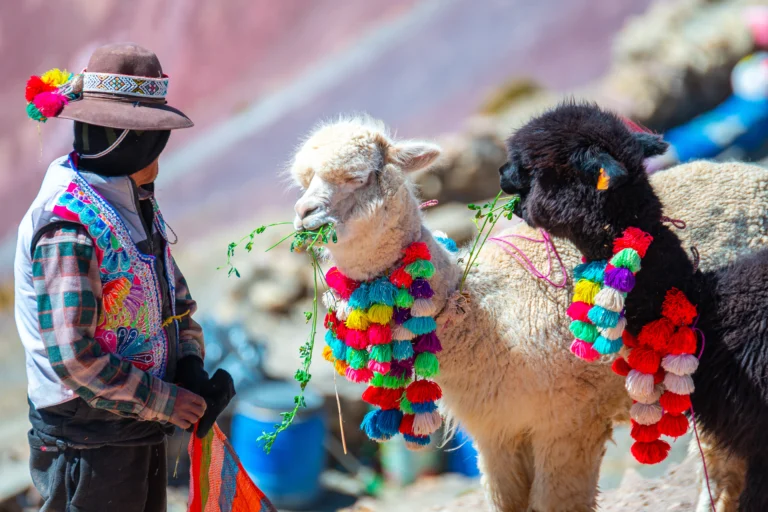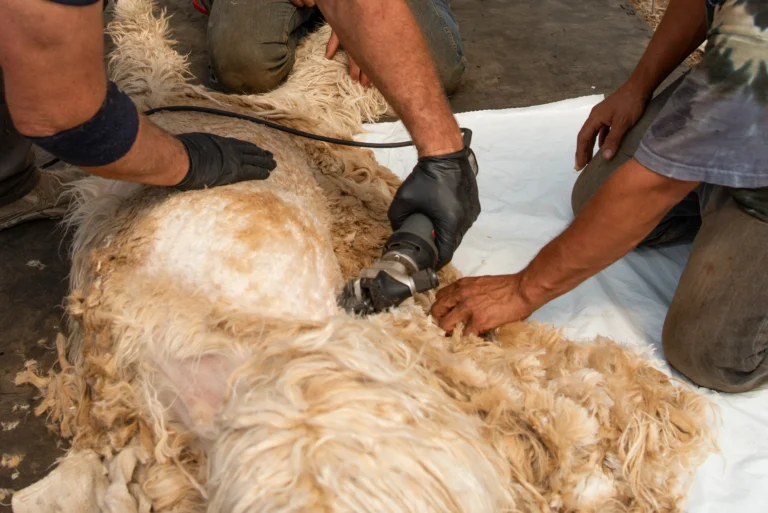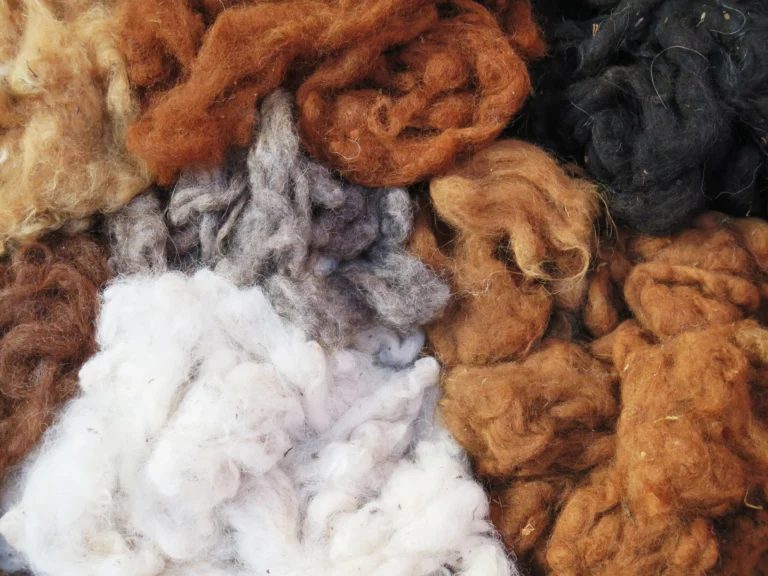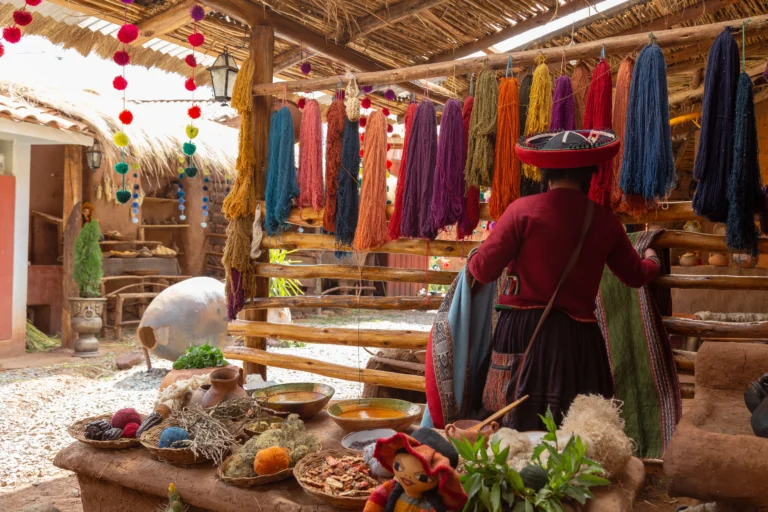Our Production
Alpaca Wool and Pelts: A Natural Symphony
Where do Alpaca wool and pelts come from?
Nestled high up in the breathtaking Andes mountains, alpacas reign as nature's true marvels. These remarkable creatures have a unique gift - their coats are soft, warm, and painted in a breathtaking array of colors, like nature's artwork. Alpaca fur, without a doubt, is one of the world's most cherished and luxurious materials.
In the heart of this story is Peru, the global hotspot for alpaca fur production. Home to more than 3.6 million alpacas, Peru's high-altitude villages are where these gentle beings call home. Local farmers, their trusted caretakers, have a yearly tradition of shearing, usually in the rejuvenating seasons of spring and summer. The fur they gather is carefully sorted by color and quality, destined for local weavers or to brighten up local markets.
Skilled local artisans work their magic, turning some of this alpaca fur into traditional textiles, a living tribute to age-old craftsmanship. These textiles find fans among tourists and travel the world as cherished handicrafts. But the allure of alpacas doesn't stop at tradition; it's very much a part of modern life too. Industrial manufacturers, armed with top-notch technology, create contemporary yarns and fabrics from alpaca fur. They source their materials from small-scale producers or maintain their own alpaca herds.
Alpaca fur production is more than just aesthetics; it's a gift to the environment and Peruvian society. Alpacas, as eco-friendly custodians of the land, leave a small ecological footprint, needing very little in terms of water and sustenance. Equally important, alpaca fur production acts as a lifeline for rural families, improving their income and living standards. And it doesn't stop there; it provides jobs for women and young individuals, each playing a part in the processes of spinning, dyeing, and weaving.
In Peru, the symphony of alpaca fur and pelts production harmonizes with respect for animals, people, and the planet. It goes beyond being a raw material; it's a symbol of Peru's rich culture and history.
But what makes alpaca fur truly unique is the kindness at its core. We're unwavering in our commitment to ethical sourcing. For example, our baby alpaca fur comes from natural mortality, born in the harsh Andean environment where about 30% of newborns don't make it due to the lack of veterinary care and a harsh environment. More importantly, Peruvian alpaca farmers don't harm alpacas for their pelts; the value of pelts is usually lower than that of alpaca wool. Alpacas are treasured primarily for their high-quality wool, which is a sustainable and economically vital resource for these communities.
Our adult alpaca fur is harvested from males at six months of age, a process vigilantly overseen to ensure the well-being of these creatures, living in harmonious groups with a ratio of one male for every 20 to 25 females.
In essence, alpaca fur is a testament to nature's wonders, a beacon of sustainable practices, and an emblem of Peru's enduring heritage. It's a living reminder that beauty and compassion can go hand in hand.
Ethical Sourcing and Product Safety
Our commitment to ethical sourcing is tightly bound to our dedication to safety and compliance. We rigorously test our toys to meet the standards of the U.S. government's Consumer Product Safety Commission. We're committed to ensuring that our products not only bring joy but also adhere to the strictest safety guidelines.
As part of our commitment to safety, we use an embroidered eye on our toys, not plastic eyes.
How is our alpaca fur dyed?
Dyeing alpaca wool is a meticulous and artistic process that involves carefully applying color to the fibers to achieve desired shades and patterns. At our facility, we take pride in using Trumpler dyes, a choice shared by many advanced European and Chinese companies. This renowned dye is known for its exceptional quality and consistency, ensuring that our dyed alpaca wool meets the highest standards.
Our commitment to sustainability and environmental responsibility is a core part of our process. We prioritize using fewer chemicals in our dyeing process, striving for a greener and more eco-friendly approach. This approach not only minimizes the environmental impact but also contributes to the overall quality of our dyed alpaca wool. Here's a general overview of how our alpaca wool is dyed:
- Scouring and Cleaning: Before dyeing, raw alpaca fleece is scoured and cleaned to remove any impurities, dirt, or natural oils. This step ensures that the dye will penetrate the fibers evenly.
- Preparation: The cleaned alpaca wool is then prepared by carding or combing it to align the fibers and create a uniform texture. This step helps ensure that the dye is evenly distributed, and that the final product has a consistent color.
- Selection of Trumpler Dyes: We choose high-quality Trumpler dyes for their reliability and range of colors. These dyes are renowned for producing vibrant and long-lasting hues.
- Dye Solution: The selected Trumpler dye is dissolved in water to create a dye solution. Our process focuses on using minimal chemicals in this step, aligning with our commitment to sustainability.
- Application of Dye: We apply dye using methods such as immersion dyeing, hand-painting, or brushing, depending on the desired results. The goal is to achieve both artistic and consistent coloration.
- Heat Setting: After dye application, the alpaca wool undergoes heat-setting to ensure the dye bonds with the fibers. We employ efficient and eco-friendly heat-setting methods.
- Rinsing and Washing: Our thorough rinsing and washing process removes excess dye and any remaining impurities or residues. This step is conducted with minimal chemical use to align with our eco-friendly practices.
- Drying: The dyed alpaca wool is dried naturally or through energy-efficient means, minimizing our environmental footprint.
- Finishing: Once dried, the dyed alpaca wool undergoes further processes such as carding or combing, preparing it for spinning or weaving into yarn or fabric.
Our dedication to using high-quality Trumpler dyes, coupled with our eco-conscious approach that utilizes fewer chemicals, results in dyed alpaca wool of exceptional quality and environmental responsibility. The art of dyeing alpaca wool is both a science and a creative endeavor, and we take great pride in delivering products that are not only beautiful but also aligned with our commitment to sustainability.
Quality Control and Artistic Variation
Our production groups, each with 20 to 40 years of experience in selecting the finest raw materials, ensure only the best fibers make the cut.
We work with four different production family groups, each bringing their unique touch to the crafting of our alpaca wool toys. While our quality control on materials, tanning, and dyeing remains consistent, we celebrate the artistic differences that make each piece special.
At the heart of our commitment is the creation of alpaca wool toys that are not only safe but also a testament to the artistry and tradition of the Andes, a harmony of quality, ethics, and creative expression.





Best Quality
Experience our unwavering commitment to quality.

Best Prices
Bringing our products to the market with aggressive pricing.

Secure Payments
SSL encryption & GoDaddy payments help protect your info.

Fast Shipping
Fast and affordable shipping to anywhere in the continental USA.
